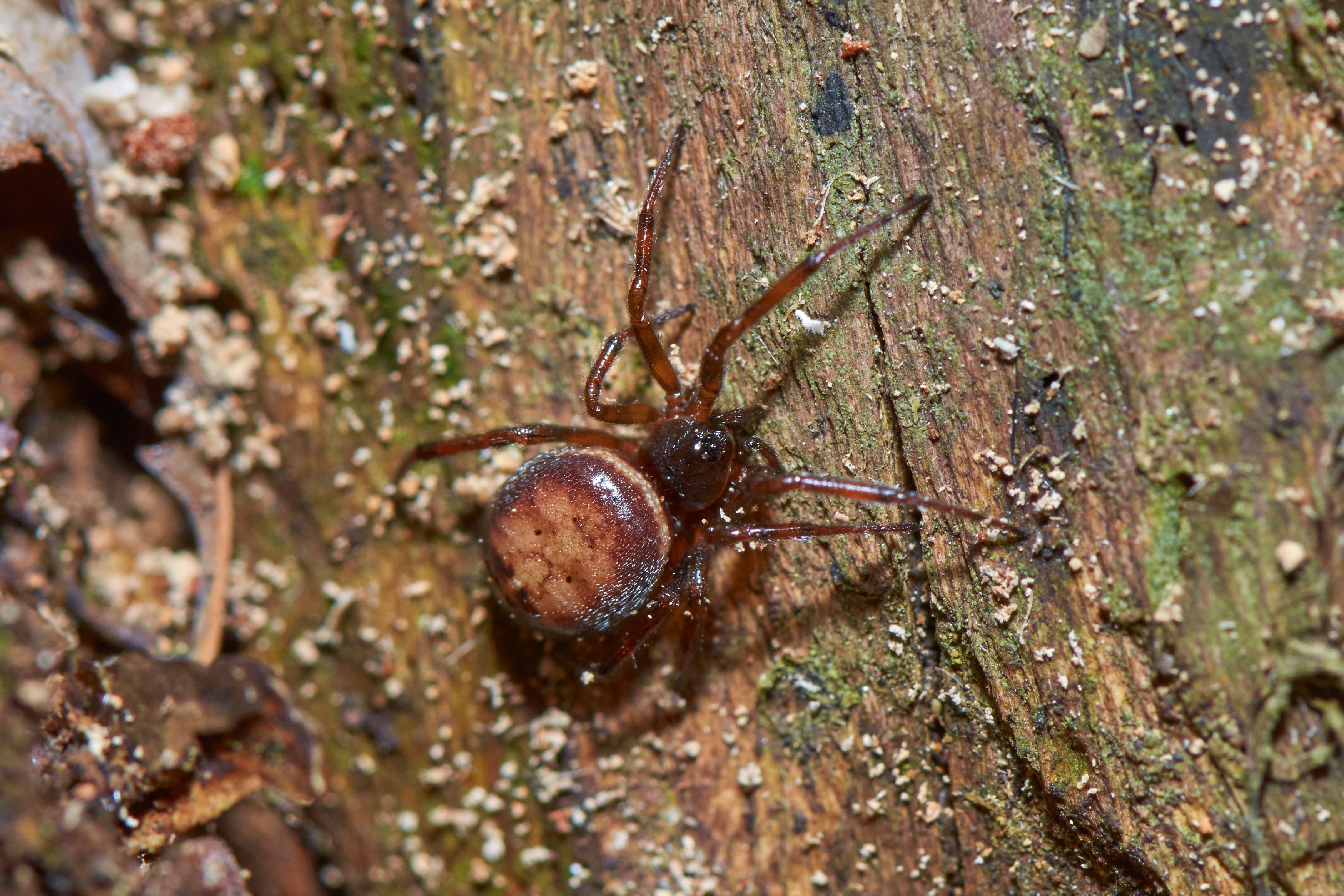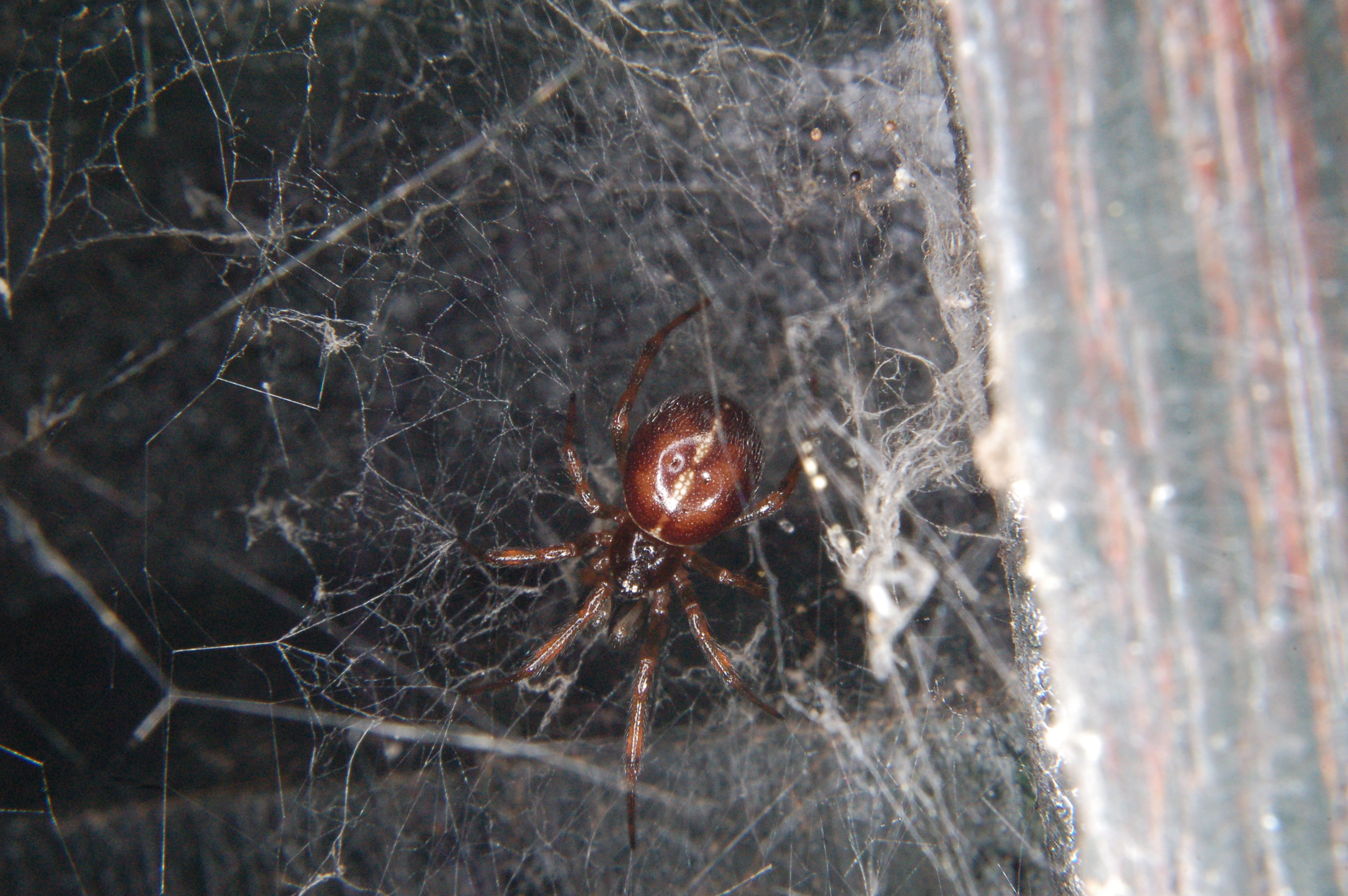Spider of the Year 2018
The Rabbit Hutch Spider, Steatoda bipunctata (Linnaeus, 1758)
belongs to the cobweb spider family (= comb-footed spiders, Theridiidae). Worldwide, this family has 2,487 species of which 228 live in Europe. The genus Steatoda is represented by 13 species in Europe, six of which can be found in Central Europe.
The Rabbit Hutch Spider is found in all European countries. Its vertical distribution is mostly from lowlands to rolling hills (up to about 800 m above sea level), although there are records up to 2,ooo m in the Alps for example.
As a web-builder the species is mostly found in or on buildings, for example under window ledges. The Rabbit Hutch Spider belongs to the less picky species and can even survive in quite dry rooms. As the name implies rabbit hutches often make a suitable habitat as well. However, they are also found outdoors, mostly in gardens, bushes and walls – especially under tree bark – in rock crevices or under stones. In places they can be quite common and the species is not regarded as endangered.
Text: Christoph Hörweg & Jason Dunlop
The body length is 4.5–7 mm in females and 4–5.5 mm in males. The body appears greasy or waxy and shiny, especially the slightly flattened abdomen. In German it is called the “Fettspinne” (Fat or Greasy Spider). The basic colour of the cephalothorax is brown to almost black, the abdomen is generally light brown becoming dark brown to black towards the edges. A more or less indistinct lighter stripe runs down the middle of the abdomen, as well as a wide pale band across the front. Usually four small dark dots can be seen (these mark the points where muscles attach inside the body). The legs are red-brown with darker rings.
The Rabbit Hutch Spider builds a three-dimensional web – usually in corners or niches – with a more or less thickly spun sheet bearing vertical threads leading upwards and further threads going out to the side. The catching threads are directed downwards. Only these have glue droplets, which are located at the bottom of the thread. Prey items become stuck here, the thread becomes detached and the spider hurries out of its retreat; usually a crevice near the web. The Rabbit Hutch Spider can overpower not only small insects but even large spiders like the house spider.
The Rabbit Hutch Spider can be found all year round, however males are usually encountered during the mating season from June to October. During mating the male makes chirping noises: the sounds are produced by pulling a sharp ridge at the front of the abdomen across a file-like ‘stridulatory organ’ at the back of the cephalothorax. In this way the female is enticed out of her retreat and mating, which usually takes place in autumn but sometimes also in spring, can be completed. The female lays ca. 50–100 pink coloured eggs in a white cocoon which is hung within the web.
Steatoda bipunctata can be mistaken for Steatoda castanea, a species which lives in similar habitats but which mostly has a lighter colouration and is only found in spring.
On the one hand, because this species is commonly found in houses and is relatively easy to recognize. On the other hand it is an example of a cobweb spider which is not dangerous, unlike the widow spiders from the Mediterranean which are venomous to people and which are rightly feared and regularly mentioned in the popular media. The chirping of the males is another peculiarity of the species.
Through choosing the Spider of the Year we not only hope that a less popular group of animals will be brought to the fore, but we also hope that researchers can obtain new data about its current distribution. In this context, enjoy the Spider of the Year and help us with your locality records or photographic documentation of this species.
The European Spider of the Year is chosen by 83 arachnologists from 26 European countries. Co-ordination is via the Natural History Museum Vienna together with the ‘Arachnologischen Gesellschaft’ (AraGes) and the European Society of Arachnology (ESA).
Text: Christoph Hörweg & Jason Dunlop
Countries involved
Albania, Austria, Belgium, Bulgaria, Croatia, Czech Republic, Denmark, Finland, France, Germany, Great Britain, Hungary, Ireland, Italy, Liechtenstein, Macedonia, The Netherlands, Norway, Poland, Portugal, Serbia, Slovakia, Slovenia, Spain, Sweden, Switzerland.
Supporting societies
- ARABEL - Belgische Arachnologische Vereniging
- ARAGES - Arachnologische Gesellschaft
- BAS - The British Arachnological Society
- CAS - Česká arachnologická společnost
- ESA - European Society of Arachnology
- GIA - Grupo Ibérico de Aracnología
- NATURADATA - Biodiversidade online
- SPINED - European Invertebrate Survey-Nederland
Contact for Europe
Dr. Milan Řezáč
Biodiversity Lab, Crop Research Institute
Drnovská 507
161 06 Praha 6 – Ruzyně
Czech Republic
reza(a)cvurv.cz
- Arachnologische Gesellschaft (2017): Atlas der Spinnentiere Europas. (Steatoda bipunctata) Abgerufen von atlas.arages.de am 12. Dezember 2017)
- Balkenhol B & Zucchi H 1989 Vergleichende Untersuchungen zur Überwinterung von Spinnen (Araneae) in verschiedenen Habitaten – Zoologische Jahrbücher, Abteilung für Systematik, Ökologie und Geographie der Tiere 116: 161-198
- Bellmann H 2016 Der Kosmos Spinnenführer. Franckh-Kosmos Stuttgart. 429 pp.
- Blick T, Bosmans R, Buchar J, Gajdoš P, Hänggi A, Helsdingen P van, Růžička V, Staręga W & Thaler K 2004 Checkliste der Spinnen Mitteleuropas. Checklist of the spiders of Central Europe. (Arachnida: Araneae). Version 1. Dezember 2004
- CSCF (Centre Suisse de Cartographie de la Faune) 2014 Fauna der Schweiz – Spinnentiere oder Arachniden (Skorpione, Pseudoskorpione, Spinnen, Weberknechte, Milben) – (link) bzw. Verbreitungskarte für N. umbratica: (link) (12. Dezember 2017)
- Gwinner-Hanke H 1970 Zum Verhalten zweier stridulierender Spinnen Steatoda bipunctata und Teutana grossa (Theridiidae, Araneae), unter besonderer Berücksichtigung des Fortpflanzungsverhaltens – Zeitschrift für Tierpsychologie 27(6): 649-678
- Hänggi A, Stöckli E & Nentwig W 1995 Lebensräume mitteleuropäischer Spinnen. Charakterisierung der Lebensräume der häufigsten Spinnenarten Mitteleuropas und der mit diesen vergesellschafteten Arten – Miscellanea Faunistica Helvetiae 4: 1-459
- Helsdingen PJ van 2016 Araneae. In: Fauna Europaea version 2017.06 – (link) (12. Dezember 2017)
- Machač O & Tuf IH 2016 Spiders and harvestmen on tree trunks obtained by three sampling methods – Arachnologische Mitteilungen 51: 67-72 – (link)
- Nentwig W, Blick T, Gloor D, Hänggi A & Kropf C 2017 araneae – Spiders of Europe, version 12.2017 – (link) (12. Dezember 2017)
- Reichholf JH & Steinbach G 1997 Die grosse Enzyklopädie der Insekten, Spinnen- und Krebstiere, Band 1. Bertelsmann Lexikon Verlag Gütersloh. 360 S.
- Steiner E & Thaler K 2004 Höhenverteilung arborikoler Spinnen (Arachnida: Araneae) im Gebirgswald der Zentralalpen (Patscherkofel bei Innsbruck, Nordtirol) – Berichte des naturwissenschaftlich-medizinischen Verein Innsbruck 91: 157-185
- World Spider Catalog 2017 World Spider Catalog, version 18.5. Natural History Museum Bern – (link) (12. Dezember 2017)





![[Translate to English:] Steatoda bipunctata (Foto: Wolfgang Kairat) [Translate to English:] Steatoda bipunctata (Foto: Wolfgang Kairat)](/fileadmin/_processed_/b/4/csm_Steatoda_bipunctata_Wolfgang_Kairat_dewolli.de_866eef42b7.jpg)